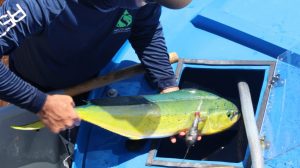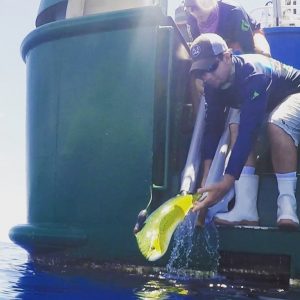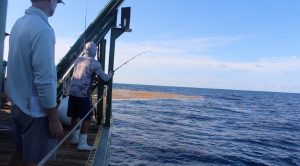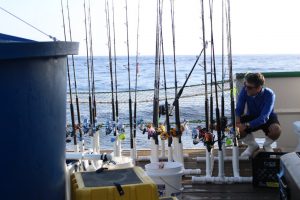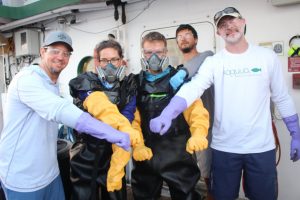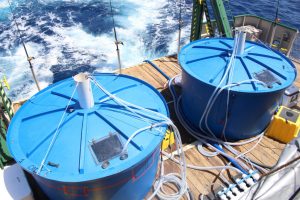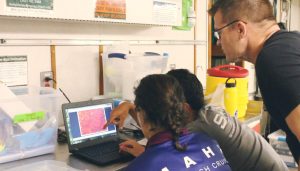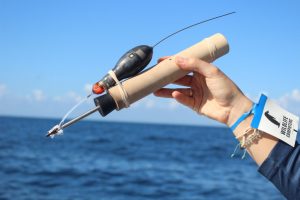Scientists Seek In-the-Wild Fish Response to Oil Exposure
– NOVEMBER 5, 2019
Much research takes place in laboratories where scientists can carefully control and manipulate conditions, but the results only tell part of a story. The next step is learning how laboratory findings play out in the real world. That’s what scientists are doing by taking their research out to sea, as they advance their studies on how fish respond to oil spills. The research team are members of the RECOVER (Relationships of Effects of Cardiac Outcomes in fish for Validation of Ecological Risk) consortium.
Following Deepwater Horizon, there was concern for how marine life, especially commercially and recreationally important fisheries, would be affected by oil exposure. Building on earlier NRDA-funded studies, the RECOVER team conducted laboratory-based research on offshore mahi-mahi at the University of Miami’s Experimental Fish Hatchery. These were the first studies to directly measure cardiac output of oil-exposed fish. Later experiments suggested that oil exposure caused changes in fish nervous system, brain, nose, and eyes. Together, these investigations revealed that the sensory and cardiovascular systems in mahi-mahi are among the most sensitive endpoints to oil exposure.
This summer, the RECOVER team took their research to the next level. They conducted experiments on wild mahi-mahi to determine what the effects of sublethal oil exposure mean in the natural environment. Their goal was to catch and then track a group of fish that had been exposed to oil alongside a control group.
Lead scientist Lela Schlenker and the RECOVER team sailed on the University of Miami’s Rosenstiel School of Marine & Atmospheric Science research vessels the R/V Walton Smith and Cuvier around the southern tip of Florida and into deep Gulf of Mexico waters. They used natural indicators (large Sargassum mats which are feeding grounds for fish and attract birds) and technical aids (donated ROFFS fishing forecasts) to find and catch 50 mahi-mahi, of suited size for tagging, over 16-days. The ROFFS forecasts provide high-resolution oceanographic analyses that are customized for recreational and tournament anglers and give information on oceanographic front locations that may hold prey and larger fish.
As the fish were caught, the team fitted each one with a Wildlife Computers’ pop-up satellite archival tag (PSAT) and then transferred it to one of two 500-gallon tanks (balancing males, females, and sizes between tanks) to recuperate. Earlier tests on captive mahi revealed that the PSATs did not affect spontaneous swimming behavior or feeding activity. Each day, once the maximum number of fish were in the tanks, the team incorporated the high-energy water accommodated fraction (HEWAF) of oil into one tank, which became the oil-exposed group. Regular monitoring kept ammonia, pH, salinity, and temperature levels constant. The team also frequently collected water samples from the oil experiment tank to monitor polycyclic aromatic hydrocarbon concentrations. Both groups of fish remained in the tanks for 12-20 hours, after which the team released the fish into the Gulf of Mexico and then repeated the process the next day.
Schlenker described how they carried out the oil-exposure process, which involved two 16-gallon turkey fryers! “We made the HEWAF samples exactly as we do in the lab, in a blender with 1 gram of oil per liter of seawater blended on low for 30 seconds. We used source oil and based our concentrations on our previous lab work and even tested a large-scale batch in the same tank and collected samples for analysis to make sure we were hitting the concentrations we wanted. In the lab, we allow the oil to settle in a glass separatory funnel for one-hour so that clumps of oil are removed from the solution, but because we didn’t want to take the fragile separatory funnels to sea, we used metal turkey fryers. Essentially, we needed something with a large volume that drained out of a valve at the bottom and those did the trick.”
The pop-up satellite archival tags will record temperature and depth data every 75 seconds for up to 96 days and collect light levels at sunrise and sunset. The team collaborated with Wildlife Computers’ engineers and custom calibrated acceleration parameters using data from two tank experiments with five captive tagged mahi-mahi at the University of Miami’s experimental hatchery. They will use those data in models to estimate spawning frequency and location. Schlenker will use the light level data in models to estimate twice daily locations and better understand migratory pathways and swimming speeds of tagged mahi-mahi. Data on temperature and depth parameters will provide the team with critical information on habitat use.
Researchers have used PSATs to study many species of pelagic fishes. However, this experiment is, to this team’s knowledge, the first to evaluate toxicant effects on wild fish behavior using data from PSATs. Releasing control and oil-exposed fish together at the same location each day provides a unique opportunity to compare how the two groups of fish performed. Using this information, the team can directly assess the effects of a brief oil exposure at levels measured during Deepwater Horizon on a highly-migratory pelagic fish species.
“This experiment took years of planning and would not have been possible without the expertise of our unique team of aquaculture experts, physiologists, expert anglers and vessel operators, tagging specialists, data wrangling experts, our fearless science communicator, and the Captain and crew of the Walton Smith,” explained Schlenker. “Catching, tagging, and oil-exposing wild mahi-mahi on a moving ship in the middle of the Gulf of Mexico was no joke, but we still managed to have a lot of fun while doing it!”
The RECOVER consortium’s Principal Investigator Dr. Martin Grosell explained the overall goal that this effort contributes towards, “The GoMRI initiative and funding provided a unique opportunity to work in larger research consortia and thereby gain a fully integrative perspective of oil impacts on marine life, ranging from molecular and cellular responses to how these responses translate to impact on free-swimming animals in their natural habitat. Links between these different levels of biological organization are rarely documented and will inform assessment of impacts from future oil spills.”
Watch these videos of the RECOVER team in action!
Listen as Lela Schlenker narrates a condensed video documentary of a June 2017 research cruise, where RECOVER scientists caught, satellite tagged, and held mahi-mahi aboard a vessel for 24 hours before release. Video credit: RECOVER consortium.
The RECOVER team completes a full workup and tagging of a mahi-mahi aboard the R/V Walton Smith in one minute! Lead scientist Lela Schlenker measures a mahi-mahi’s length, assesses its condition, and takes a fin clip (for genetic processing later). After placing a pop-up satellite archival tag from Wildlife Computers into the fish’s dorsal area, she, Dr. John Stieglitz, and Ron Hoenig quickly place the mahi-mahi into the control recovery tank. Video credit: RECOVER consortium.
During the RECOVER multi-week cruise, two vessels (the University of Miami’s Rosenstiel School of Marine & Atmospheric Science R/V Walton Smith and the Cuvier) set out looking for mahi-mahi. On this day, the crews worked near a large Sargassum patch. Principal Investigator Dr. Martin Grosell (blue shirt), Ph.D. student CJ McGuigan (gray shirt) – both from the University of Miami’s Rosenstiel School – and postdoctoral researcher from UC Riverside Dr. Justin Greer work quickly so that the lines can be reset on another area of the Sargassum patch. The R/V Walton Smith is in the background along with some birds giving signs that fish are there. Video credit: RECOVER consortium.
Read related stories about RECOVER and their fish research:
- Study Finds Slick Oil has Greater Impact than Source Oil on Fish Development
- Study Finds Oil, UV Radiation, and Temperature Affect Mahi Survival Processes
- Getting to the Heart of Oil Spill Impacts on Gulf Fish
- Video Shows New Research Tactics for Mahi-Mahi Tagging
By Nilde Maggie Dannreuther. Contact maggied@ngi.msstate.edu with questions or comments.
************
This research was made possible in part by a grant from the Gulf of Mexico Research Initiative (GoMRI) to the consortium Relationship of Effects of Cardiac Outcomes in Fish for Validation of Ecological Risk II (RECOVER II.)
The Gulf of Mexico Research Initiative (GoMRI) is a 10-year independent research program established to study the effect, and the potential associated impact, of hydrocarbon releases on the environment and public health, as well as to develop improved spill mitigation, oil detection, characterization and remediation technologies. An independent and academic 20-member Research Board makes the funding and research direction decisions to ensure the intellectual quality, effectiveness and academic independence of the GoMRI research. All research data, findings and publications will be made publicly available. The program was established through a $500 million financial commitment from BP. For more information, visit https://gulfresearchinitiative.org/.
© Copyright 2010-2019 Gulf of Mexico Research Initiative (GoMRI) – All Rights Reserved. Redistribution is encouraged with acknowledgement to the Gulf of Mexico Research Initiative (GoMRI). Please credit images and/or videos as done in each article. Questions? Contact web-content editor Nilde “Maggie” Dannreuther, Northern Gulf Institute, Mississippi State University (maggied@ngi.msstate.edu).

